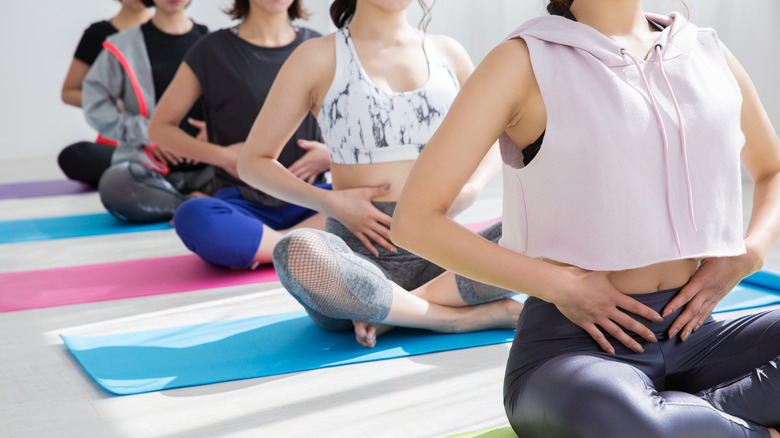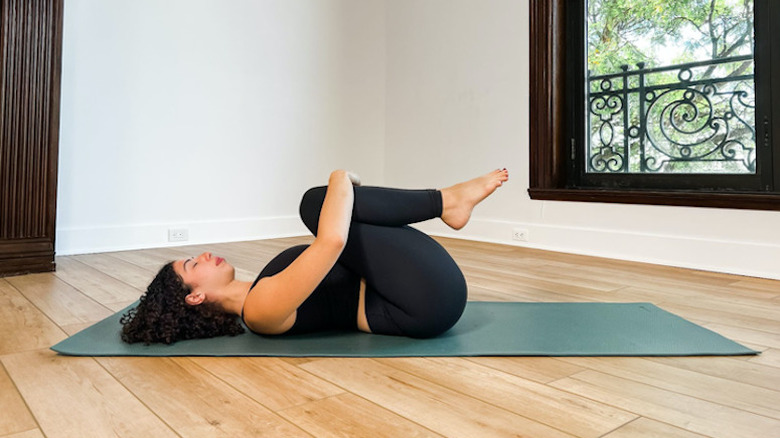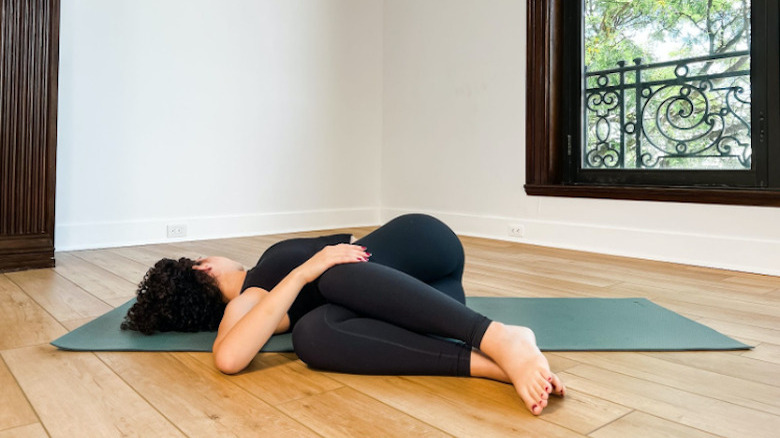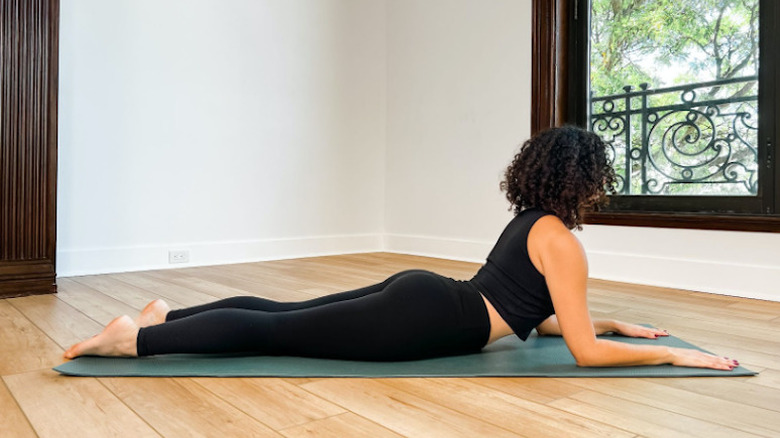Yoga Instructor Shares 3 Gentle Poses That Can Help Alleviate Constipation
Stressful day? There's a yoga pose for that. Sore back? There are a few for that, too. What about when you're struggling to use the bathroom? Everyone has experienced the uncomfortable symptoms of constipation at one point or another. And with 25 to 45 million people suffering from irritable bowel syndrome, according to About IBS, it's really no surprise that constipation is the most common complaint doctors hear in regard to the gastrointestinal tract (per Johns Hopkins Medicine).
We know that upping our water and fiber intake can help when we're backed up, but sometimes our bodies need a little extra push. That's where yoga comes in, says Lindsay Monal, registered yoga teacher and curriculum director at YogaRenew Teacher Training, the largest online yoga teacher training school worldwide.
"As a practicing yoga teacher, I'm guilty of thinking yoga can help with basically any ailment," Monal explains. "So often, most of the symptoms we're having are a result of an unbalanced diet, lifestyle, or excessive stress. Yoga can help bring awareness to the areas in our bodies and lives that we may be ignoring, and through this consciousness, we can work to cultivate a greater sense of ease, on the toilet and off. Yoga can help us reduce stress, and certain physical postures can support in stimulating our digestive system." In an exclusive interview with Health Digest, Monal details how yoga benefits the digestive system and walks us through poses that can ease stubborn constipation.
Pose 1: Apanasana
"Apanasana, literally translated as 'downward moving' or 'wind relieving' pose, is the number one yoga posture that comes to mind when students are struggling with constipation," Monal explains. "It's a super accessible posture that just requires you to hug your knees into your chest while lying down on your back."
So when we get the familiar feeling that nature is calling, that is the defecation reflex at work (per Healthline). When stool makes its way to the rectum, causing tissues to stretch, a signal is sent to the brain, which triggers the defecation reflex. In response, our internal sphincter loosens and our external sphincter tightens, as our body prepares to evacuate the bowels. However, sometimes these reflexes aren't working as they should. Therefore, belly massages or gentle yoga poses, like Apanasana, can help to encourage them.
"In this shape, you're gently constricting the abdominal organs and helping to relieve tension in the muscles of the pelvic floor. Try this posture for a few breaths to help yourself initiate a bowel movement," explains Monal.
Pose 2: Jathara Parivartanasana
Fortunately, transitioning from the Apanasana pose to this second one, known as Jathara Parivartanasana, should be simple. "Keep your knees together as much as you can while dropping both knees over to the right. If your knees can't stay stacked comfortably, slide a blanket or pillow between your knees for additional support. Try to keep the opposite shoulder grounded on the earth and you'll really feel the twist along your whole spine," according to Monal.
Intestinal ischemia — a condition characterized by reduced blood flow to the intestines — occurs for several reasons and can impact how our intestines function, according to Mayo Clinic. When the small or large intestines are affected, constipation can follow.
Luckily, swiveling around can help. "Twisting to the right first follows the natural direction of your digestive system and will help clear any blockages in your intestines," Monal notes. "After your right side twist, repeat the posture on the left side for the same amount of time to really wring your body, and any stuck waste out."
Pose 3: Salamba Bhujangasana
"After your twist, flip yourself over and find Sphinx pose, Salamba Bhujangasana, a supported backbend," Monal instructs. "To find sphinx pose, come to lay face down on your floor or mat. Slide your elbows directly under your shoulders or just slightly in front of them. Press down into your forearms to lift yourself up as you draw your shoulder blades together and down your back. Press the tops of your feet, legs, and hips down into the mat as you find your backbend. Try not to dump your weight into your lower back, but instead, consciously work to distribute the curve of this backbend through your whole spine."
After putting a little pressure on the digestive tract with the first two poses, monal says, "This posture is great to help stretch the front line of the body and create space through the abdomen. In this pose, the pressure placed on the abdomen helps to activate the digestive organs, while also relaxing the nervous system."
For yoga beginners, Monal suggests being careful and not overextending your body. "If something hurts, or feels like it's too much for you, back off, you know yourself best," she explains.
To learn more about online yoga teacher training visit YogaRenew. You can also connect with Lindsay Monal and YogaRenew on Instagram for more yoga tips.




